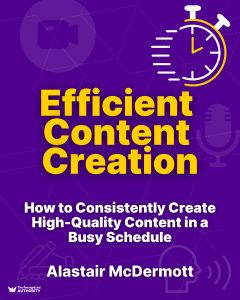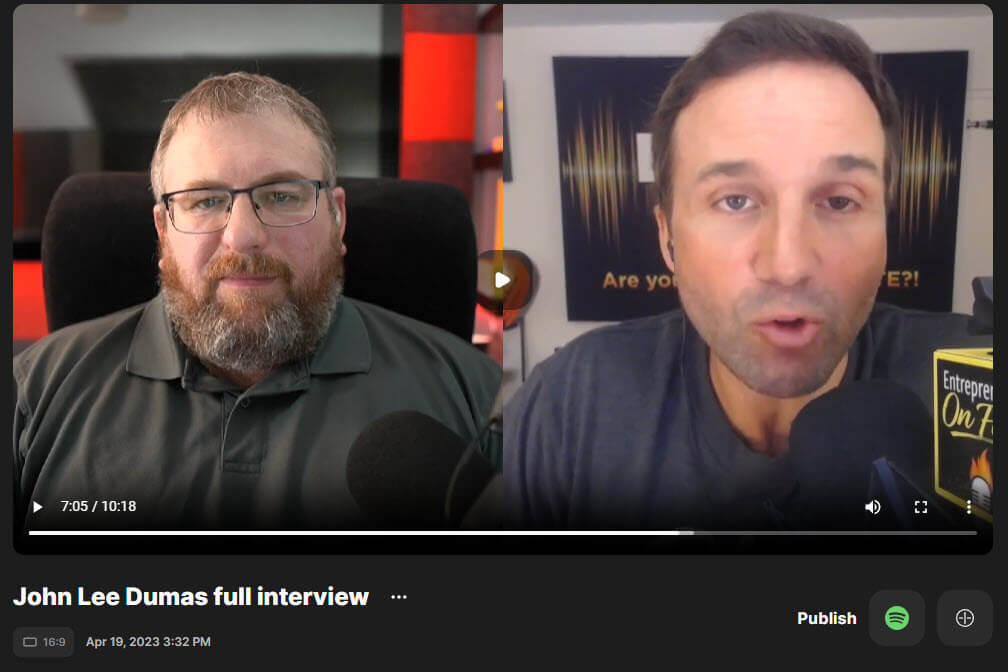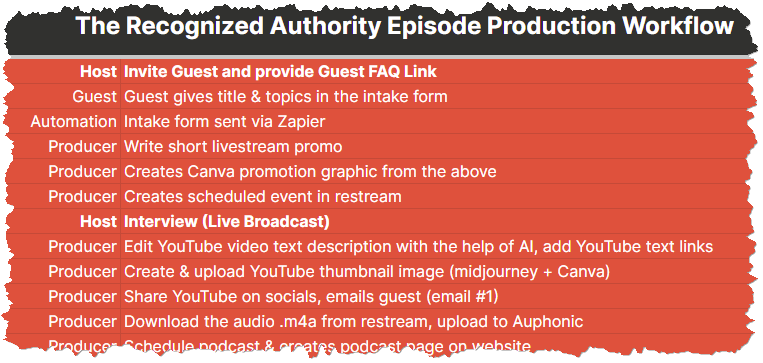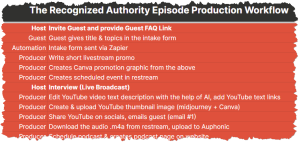
Also Available on Amazon
Efficient Content Creation
How to Consistently Create High-Quality
Content in a Busy Schedule
No time for content creation? You’re in good company – most business leaders feel that trying to consistently create high-quality, impactful content seems overwhelming, and even impossible to consider, because you simply don’t have time for it.
But, it doesn’t have to be that way.
With this guide, you’ll master actionable, time-efficient strategies that make content creation less of a chore, so that you can create an abundance of quality, authority building content.
Table of Contents
Practical Example
Over the past three years, I’ve released more than 150 podcast episodes.
However, it was only from the start of this year that I began to take content repurposing more seriously. Here’s what that looks like.
Now when I record a 45 minute podcast interview, it gets broadcast live – to LinkedIn, YouTube and Facebook.

That full live broadcast is a YouTube video on my channel, and is published as an audio podcast episode at 06:01am on Monday morning.
There’s a podcast episode page on my website that includes the full YouTube video, a podcast audio player, show notes from the podcast including episode description, guest bio, links to resources and books mentioned in the conversation, and a full text transcript of the conversation.
The most recent addition to my team is a video editor (hey Matty!). He’s usually going through all the previous interview video to create highlights, but for this particular episode, he’s going to create five 60-second short video clips. We’ll add a text description for each one, and then we’ll have a short video clip to publish to promote the episode – and build my authority – going out every single day of the week on LinkedIn, YouTube, Instagram, Twitter and even TikTok.
The full episode is promoted another day, and he’ll edit the 5 clips together as a highlights package of the episode to go out on YouTube (which will perform better than the long form video).
That took me an hour
If I’m good, that all takes me less than an hour of my time, including the 45 minute interview.
The total time that I absolutely have to commit to in order to get all of that content creation and publishing, including the 45 minute interview is ~55 minutes, and that’s because I like to chat to the guest for 10 minutes in the pre-show.
It took time to get to this level of output: I started off with a simple, pre-recorded audio-only podcast and layered on top of that as I learned more about content creation.
Time-Management Recap
As experts and business leaders, our time is precious – it’s the only resource we can’t replenish.
Here’s a quick recap of general time-management principles we should be following regularly:
-
Prioritize Ruthlessly
Focus on high-value tasks that directly align with our goals and bring the most significant impact. We need to identify the critical few tasks that will move the needle forward and allocate our time and energy accordingly. It's easy to get caught up in low-value activities that don't significantly contribute to overall objectives.
-
Time-block
Dedicate specific blocks of time for different activities, such as focused work, meetings, and strategic thinking - important but not urgent activities that don't normally get on our calendar. During these time blocks we should eliminate distractions.Tools like the Pomodoro Technique can help with focus and time-blocking.
-
Schedule Strategically
Create a structured plan and schedule for our day, week, and month. We can break down larger projects into smaller, manageable tasks and allocate specific time blocks for each activity. By setting deadlines and milestones, we'll keep ourselves accountable and on track. Frameworks like the 12-Week Year, Eisenhower Matrix, Getting Things Done (GTD), or OKR (Objectives and Key Results) can greatly aid in planning and scheduling.
-
Delegate & Automate
We cannot - and should not - be doing everything ourselves. It's crucial to delegate tasks that don't require our expertise or direct involvement. Clearly communicate expectations and empower capable team members who will take ownership of the task, allowing us to focus on tasks that do require our direct involvement. Anything that can be automated, should be automated.
-
Continuous Improvement
We should evaluate our productivity and time-management practices. Try to catch ourselves when we do something that should be delegated or simply not done. We should stay open to adopting new tools, techniques, and technologies that can enhance our productivity and time-management skills.
1. Plan Your Content Strategy

The first step in efficient content creation is a content strategy planning session.
This doesn’t need to be a hugely time consuming step in itself, but it’s important to do it because it’s so easy for us to get sidetracked into creating content ad hoc.
Having a strategy in place ensures that you’re focusing first on creating highest priority content that is directly aligning with your business goals.
1. Define Content Goals
What you do want to achieve by creating & sharing content? Your goals could include:- Generating leads
- Growing your audience
- Establishing you as an authority
- Attracting great employees to your team
- Building relationships with potential clients
- Building relationships with authorities in your field
2. Identify Your Target Audience
Your content should be tailored to the needs, interests, and pain points of your target audience.- Who are they?
- What are their goals?
- What are their concerns?
- What problems are they facing?
- What is keeping them up at night?
- What sources or brands do they trust?
3. Core Topics
You already have a good idea what the core topics are that you’ll talk about. The problems that your clients are facing, and your solution to those problems are top of mind. Now it’s time to get a bit more organized.- Categorize: Divide your topics into broader categories related to your business. It promotes a structured approach and facilitates easier navigation for your audience.
- Prioritize: Based on relevance to your business, audience interest, or industry trends, assign priority to each topic. Prioritizing helps in focusing on topics with the most impact.
- Map Out Content: Create a visual map, linking related subtopics to their respective core topics. It aids in visualizing the content structure and spotting potential gaps.
- Content Calendar: Plan when to tackle each topic in your content calendar. Consider factors like seasonality or product launches.
4. Choose Content Format
There are numerous content formats to choose from – videos, blogs, podcasts, infographics, social media posts, and more. Each format has its own strengths and is suited to different types of content. Writing is slow, but is particularly useful for developing your thinking:“I don’t write because I have ideas – I have ideas because I write”I think writing is incredibly important for everyone reading this to develop as a skill. But after you have some miles under your belt, after you have found your voice and point of view, writing is no longer the most efficient way to create content. Video is. Video content is particularly time-efficient, as it can be created as simply as getting on a Zoom call, and it can easily be repurposed into other formats. We’ll cover video in more detail shortly.
2. Leverage Video
Video vs Writing
Video and writing each cater to different needs and circumstances of thought leaders, offering distinct strengths in content creation.
Video is more engaging for viewers and is incredibly easy to repurpose into audio, or written content, or even more video e.g. clips, highlights, etc.
Writing is significantly slower to produce, but fosters a depth of understanding during creation. It also lets readers scan through information at their pace, something difficult to do with video.
Both activities and mediums provide clear value and the balance between them hinges on your available time, and where you are in terms of professional development.
The efficiency of video creation – just get on a Zoom call – and the repurposing potential makes it ideal for busy thought-leaders.
Recording Video
Consider the meetings, presentations, and discussions you participate in daily – each of these instances could be recorded and – sometimes with with judicious editing – transformed into informative video content.
"Always Ready" Video Setup
Having an always ready video setup at your desk is a huge time-saver, and will ensure you always look and sound amazing, even on your regular video calls.
Quality of audio & video is far more important than most realise, as it will make you appear smarter, more likable, and more competent:
Despite identical content, people evaluated the research and researcher less favorably when the audio quality was low, suggesting that audio quality can influence impressions
Eryn J. Newman & Norbert Schwarz, University of Southern California
Learn more about this in my conversation with Professor Schwarz: How Quality Audio Makes You Sound Smarter (episode 34 of The Recognized Authority).
It also means you’re prepared to capture all of the content creation opportunities that are happening daily.
This setup should include a high-quality microphone, soft lighting, and a camera placed close to eye level. Here’s a quick guide on how to optimize your video setup:
-
Position Your Camera
Keep the camera at eye level, pointing directly at you to avoid unflattering angles. You can use a tripod or stack books to achieve this height. A direct line of sight to the camera helps maintain natural and effective communication.
-
Master Eye Contact
Looking directly into the camera simulates eye contact with your audience. It may take some practice, but this technique is worthwhile as it fosters a more personal connection with viewers, making your communication more engaging.
-
Choose Your Equipment
For good video quality, Logitech or Elgato webcams are a solid starting point. For a high-end professional look, consider the Sony A6100 camera with a Sigma 16mm lens and an Elgato Cam Link 4K. The right equipment can significantly improve the quality of your video content.
-
Invest in Quality Audio
Audio quality is often more important than video. While condenser microphones are excellent in sound-treated environments, they can pick up too much background noise in untreated spaces. A dynamic microphone, particularly a USB one for easy setup, is a more forgiving choice outside of a soundproofed studio.
-
Minimize Echo
A room with too much echo can negatively impact your audio quality. Use sound-absorbing materials such as curtains, carpets, or specially designed acoustic panels to dampen echo. Avoid rooms with bare walls and hard surfaces as they tend to bounce sound around, creating echoes.
-
Optimize Lighting
Good lighting significantly impacts video quality. Utilize ring lights or soft LED lighting to illuminate your face, with the main light source in front of you. Natural light can also be beneficial if available. Ensure that you don't sit with a significant light source, such as a large window, behind you on camera.
-
Suitable Background
A clean, professional background is ideal. If a clean real-life background isn't possible, opt for a professional-looking virtual background. For practical guidance on selecting and setting up video call backgrounds, refer to this guide.
-
Test Your Setup
Always do a trial run before important calls. Record a brief video to check audio and video quality, making adjustments as necessary. This ensures that you present your best self during your video calls.

Get Interviewed
If you don’t want to use your day-to-day conversations, you can record interviews and conversations specifically for marketing use.

3. Repurpose Your Content
Repurposing is an efficient way to get the most out of your content.
While you can repurpose any type of content, starting with video is particularly time-efficient in creating diverse content pieces as the only stage that you need to personally be present for is the actual video recording – everything else can be delegated.
Your team can transform your videos into various formats – blog posts, social media updates, podcasts, newsletters, and more. This not only extends the lifespan of your content but also allows you to reach a wider audience.
One video becomes 100 content assets
Here’s just a sample of the content that could be created from a video recording:
- Video clips: the video can be cut into short, engaging clips suitable for social platforms like LinkedIn, Instagram, etc
- Podcast: extract the audio to create a podcast episode
- Transcription: transcribe the video into text which can then be used in many other ways
- Blog posts: the transcription can be edited and turned into several blog posts
- Email: it could also be used to create emails for broadcast
- Book: you could combine insights from multiple videos to write a book
There are lots of other potential formats, including webinar outline, infographics, case studies, whitepapers and more. Transcription tools and generative AI can be of huge help with the repurposing process.
Proactive Content Repurposing
Repurposing works best when you know beforehand that you’re going to be doing it.
When you know in advance, you can extract more value from a single piece, and small tweaks can make a big difference in making it suitable for more channels.
Consider the format
When you’re answering questions, it’s useful to speak in self-contained soundbytes. These concise, focused responses encapsulate your message and make it easier for your team to repurpose.
Consider the length of the desired output; a 60-second video requires more than a one sentence answer. You need to balance being too short with your answers or monologuing like a movie villain.
Intentional framing
One useful tip for repurposing video is intentional framing, where you incorporate the question in your response when answering questions.
This makes your answer suitable for stand-alone use when the interviewer is cut out of the video or audio.
As you get more experienced with answering questions on video this will become second nature to you.
4. Use Batching
Batching significantly improves productivity because you eliminate context switching – the time wasted on switching between different tasks.
For instance, allocate a block of time just for ideation, brainstorming topics and creating outlines for all your content at once.
Dedicate a specific time on your calendar for content creation, whether it’s writing articles or recording video. Get all your equipment or setup done, saving you from repeated setups and teardowns – it’s far more efficient to record several videos in one session or write multiple articles in one sitting, especially when your environment is primed and your mind is focused.
Create checklists
One thing that’s incredibly useful to do is identify the series of tasks required in your content creation process, and create a simple checklist or SOP for yourself.
For example, here’s the workflow for Season 2 of The Recognized Authority podcast:
Documenting the process like this helped me figure out what I could delegate, automate or simply remove from the process.
If you look closely, you’ll see that – listed as Host – I am only required for 2 steps in the process now:
- inviting the guest, and
- turning up for the interview
Having these checklists and SOPs are especially important for busy people because they help you make less decisions. This reduction in cognitive load frees up your brain and saves energy for higher priority tasks, and help ensure you don’t miss anything important.
5. Use Existing Content
You’ve already got a lot of content ideas, and even ready-to-publish text laying around.
The ideas are in your email inbox, questions from clients and prospects. The answers are often in your sent items, thousands of words you’ve written.
Is there a question that you find yourself answering repeatedly?
Turn itinto a blog post or video. In fact, if it’s asked frequently, it’s probably worth turning it into a series of content focusing on that issue.
Did you recently explain a complex concept to a client?
Record a video explaining it, or podcast episode, or turn it into a how-to blog post. Or all 3!
And it’s not just in email – your business has product documentation, SOPs, FAQs, and more.
SOPs can become ‘behind-the-scenes’ posts that establish trust and transparency.

FAQs can easily be repurposed into blog posts or quick social media snippets that address common customer queries.
You can use all of this content directly, or indirectly as sources of ideas. Have your team curate and repurpose. Adapt it to suit your content strategy and your audience’s preferences.
6. Accept the Imperfect

Perfectionism a trap that many fall into, mistaking it for the pursuit of excellence.
Perfectionism is simply procrastination by another name. Done is better than perfect.
You might not feel ready. That’s ok, but…
Don’t wait for “ready”
We need to start before we feel ready, because the only way to feel ready is with experience, and the only way to get experience… is to start!
Regularly delivering good content builds momentum and maintains engagement with your audience. Sharing your insights in an imperfectly lit video might not be ‘perfect’ – but it’s far better than not sharing them at all.
Publish your content, get feedback, refine, and repeat. Continuous improvement and over time, the consistent delivery of good content will establish your reputation and authority.
The Pareto Principle – 20% of your efforts will yield 80% of results – is useful in terms of identifying where you should be focusing your efforts. It’s also a good rule of thumb for thinking about the quality of the content – aim for high-quality content, but remember, consistent ‘good’ content will have more impact than sporadic ‘perfect’ content.
The time spent on researching, outlining, and getting the key messages right, contributes to 80% of the quality of your content. This is where you should be focusing your efforts – on thorough preparation and clear communication of your key points.
Don’t let a quest for perfection stop your forward progress.
7. Delegate and Automate

Delegation is essential for efficient content creation.
It’s hard to brainstorm topics, write an outline, record a video, only to then have to spend another half-day or day editing and producing it.
Do not get bogged down in execution
Execution is not a wise use of your time.
Delegate as much as possible. All the tasks that don’t require your direct presence or expertise should be delegated to your team. They can edit, repurpose and publish content for you.
- If you don’t have a team yet, start to build one – there are plenty of great people who are available on a part-time or full-time basis who can help with this.
- Automation is also a great way to get tasks off your plate. In fact, it’s good to automate as many steps as possible so your team aren’t wasting time on low value tasks either.
If you need help with any of this, DM me, I’d be happy to give you suggestions on how to start.
As a leader, your role is to direct the strategy
You should be turning up to plan and create the content. Someone else should be handling every other stage of the process, leaving you free to focus on strategic, high-value activities.
Reframe: Content is an Investment
If you simply don’t have time for content, then it’s not a priority for you – and that’s okay.
Becoming an authority in your field is not a requirement for success (but it does make things a lot easier).
Many business leaders remain “invisible”, known only to their direct network, and have a successful business.
This works if you have more opportunity than you can handle, and your network contains the right people, and you take active steps to keep growing that network as it will naturally shrink by default. You’ll also need to proactively ask for referrals.
You could even choose the “dark side” and use outbound techniques, like cold calling, email outreach, and LinkedIn messaging.
If you do choose the path to authority through content, it’s not an easy road, but it is incredibly powerful.

Reframe the way you look at content creation, and be especially wary of traditional attribution metrics that are just not relevant thought-leadership content, particularly in B2B markets.
- Every piece of content you create adds to your “body of work“.
- Every piece of content you create is an opportunity to engage and grow your audience.
- Every piece of content you create you can republish again.
Yes, there’s a significant cost, mostly in terms of time. But if you’ve read this far, you know how to optimize for that.
The content is not the compounding asset.
The audience is the compounding asset.
It took me too long to figure that out.Alex Hormozi
Delegate It to my Team
If you’re looking for a hands-off, done-for-you solution I have something tailored just for you – Authority Accelerator.
We make content creation completely effortless for you.
I will interview you once or twice a month and from that my team will create engaging, digestible clips perfect for daily social media updates.
We’ll even publish them on your social channels for you, saving hours of your time every week.
No more time wasted on:
- writing
- editing
- uploading files
- wrestling with platform-specific details
We’ll handle it all.
If you’re interested in learning more, check out the insanely great value Authority Accelerator “Starter Pack” special offer.
Thank you for reading all the way down – I want to make this as useful as possible for you and I’d love to get your feedback on this guide.
- Has it been useful for you? If so, please share it with others in your network!
- Is there anything incorrect or that you’d like me to address? Please let me know on any of my socials and I’ll fix it asap.